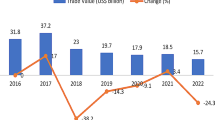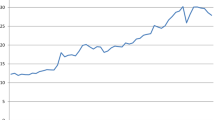Abstract
The paper analyzes the dynamics of Turkey’s trade integration into the various economic blocs of the world system as well as into the peripheral subsystems of Eurasia and Mediterranean space using a gravity GMM model, for the period 1996 through 2011. The findings reveal that the trade pattern of Turkey is multispatial but without a deep integration with the EU or any other economic bloc, despite the custom union agreement with the latter since 1995. Further, the trade dynamics of Turkey is consistent with fundamentals such as size of the markets, location and other relevant factors, while, the quasi time invariant structural factors such as geography, culture and history seem to foster the Turkey’s trade relations with specific Eurasian subsystems. The rising multipolarity of the world system-cum-the fragile architecture of interests in the broader Eurasian region affect unavoidably the role and the position of Turkey itself as well as its strategic orientations. Conversely, an economically diminishing Europe seems to be unable to pursue with consistency specific Eurasian policies including the matter of official accession of Turkey in the EU.
Similar content being viewed by others
References
Amin, S. (2006). Beyond US hegemony? Assessing the prospects for a multipolar world. London, New York: Zed Books.
Antonucchi, D., & Manzocchi, S. (2006). Does Turkey have a special trade relation with the EU? A gravity model approach. Economic Systems, 30(2), 157–169.
Arellano, M., & Bond, S. (1991). Some tests of specification for panel data: Monte carlo evidence and an application to employment equations. Review of Economic Studies, 58(2), 177–297.
Arellano, M., & Bover, O. (1995). Another look at the instrumental variable estimation of error-components models. Journal of Econometrics, 68(1), 29–51.
Arnon, A., Spivak, A., & Weinblatt, J. (1996). The potential for trade between Israel, the Palestinians and Jordan. World Economy, 19(1), 113–134.
Blundell, R., & Bond, S. (1998). Initial conditions and moment restrictions in dynamic panel data models. Journal of Econometrics, 87(1), 115–143.
Blundell, R., & Bond, S. (2000). GMM estimation with persistent panel data: An application to production functions. Econometric Review, 19(3), 321–340.
Brakman, S., & van Bergeijk, P. A. G. (2010). The gravity model in international trade: advances and applications. Cambridge: Cambridge University Press.
Braudel, F. (1995). The Mediterranean and the Mediterranean World in the Age of Philip II (Vol. 1). Berkeley: University of California Press.
Cohen, B. S. (2004). The geopolitics of Turkey’s accession to the European Union. Eurasian Geography and Economics, 45(8), 575–582.
Davutoglu, A. (2008). Turkey’s new foreign policy vision: An assessment of 2007. Insight Turkey, 10(1), 77–96.
De Benedictis, L., & Salvatici, L. (2011). The trade impact of European Union preferential policies: An analysis through gravity models. Berlin Heidelberg: Springer-Verlag.
De Benedictis, L., & Vicarelli, C. (2004). Trade potentials In Gravity panel data models. Institute for Studies and Economic Analysis, Working paper, 2004/44.
Ersen, E. (2014). Rise of new centres of power in Eurasia: Implications for Turkish foreign policy. Journal of Eurasian Studies, 5(2), 184–191.
Huntington, P. S. (1997). The clash of civilizations and the remaking of world order. London: Simon & Schuster UK Ltd.
Karagoz, K., & Saray, M. Ozan. (2010). Trade potential of Turkey with Asia–Pacific countries: Evidence from panel gravity model. International Economic Studies, 36(1), 19–26.
Krugman, P. (1980). Scale economies, product differentiation and the pattern of trade. American Economic Review, 70(5), 950–959.
Krugman, P. (1991a). Geography and trade. Leuven: Leuven University Press.
Krugman, P. (1991b). Increasing returns and economic geography. The Journal of Political Economy, 99(3), 483–499.
Laaser, C. F., & Schrader, K. (2002). European integration and changing trade patterns: The case of the Baltic States. Institute of World Economics, Working Paper 2002/1088.
Martinez-Zarzoso, I., & Lechman, F. N. (2003). Augmented gravity model: An empirical application to Mercosur-European Union trade flows. Journal of Applied Economics, 6(2), 291–316.
Morelli, V. (2013). European Union enlargement: A status report on Turkey’s accessions negotiations. Congressional Research Service, Report for Congress.
Moser, C., Nestmann, T., & Wedow, M. (2008). Political risk and export promotion: evidence from Germany. World Economy, 31(6), 781–803.
Roodman, D. (2006). How to do xtabond2: An introduction to difference and system GMM in stata. Center of Global Development, Working paper 103.
Roodman, D. (2009). A note on the theme of too many instruments. Oxford Bulletin of Economics and Statistics, 71(1), 135–158.
Steinbock, D. (2012). The eurozone debt crisis: Prospects for Europe, China, and the United States. American Foreign Policy Interests, 34(1), 34–42.
Suvankulov, F., & Guc, Y. (2012). Who is trading well in Central Asia? A gravity analysis of exports from the regional powers to the region. Eurasian Journal of Business and Economics, 5(9), 21–43.
UNCTAD. (2014). (http://unctad.org/en/pages/Statistics.aspx).
United Nations Commodity Trade Statistics Database (UN COMTRADE) (2014). http://comtrade.un.org/db.
Vicarelli, C., & de Nardis, S. (2003). Currency union and trade: The special case of EMU. Review of World Economics, Welwirtschaftliches Archiv, 139(4), 625–649.
Windmeijer, F. (2005). A finite sample correction for the variance of linear efficient two-step GMM estimators. Journal of Econometrics, 126, 25–51.
World Bank. (2014). Evaluation of the EU-Turkey Customs Union. Report, 85830-TR.
Author information
Authors and Affiliations
Corresponding author
Rights and permissions
About this article
Cite this article
Ageliki, A., Ioannis, P. Eurasian orientation and global trade integration: the case of Turkey. Eurasian Econ Rev 6, 275–287 (2016). https://doi.org/10.1007/s40822-015-0038-1
Received:
Revised:
Accepted:
Published:
Issue Date:
DOI: https://doi.org/10.1007/s40822-015-0038-1




